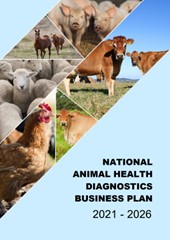Australia has a favourable animal health status, free from many of the economically important diseases that occur in other parts of the world. Laboratory diagnostics are key components of Australia’s animal health system.
Quality-assured and fit-for-purpose diagnostic capability and capacity:
- enables the early detection of emergency and emerging animal diseases
- facilitates access to international markets
- supports the management of endemic pests and diseases.
These functions underpin national and international trade in livestock products and help to safeguard the economy, environment and health of Australians.
The department is part of a national network of state and territory governments, the CSIRO, universities and industry groups responsible for managing and implementing animal health laboratory diagnostic activities in Australia.
This network supports a nationally coordinated approach to ensuring that Australia continues meeting international and domestic expectations and requirements for relevant animal health diagnostic laboratory services.
National laboratory policies
The department, on behalf of its stakeholders and the Animal Health Committee, maintains the following national policies and guidelines applicable to animal health and other relevant laboratories in Australia:
- Standards & Guidelines: Generation and Analysis of High Throughput Sequencing Data
- Policy for the transfer of biological specimens to overseas laboratories
- Guidelines for Implementing Diagnostic Next Generation Sequencing
National Animal Health Diagnostics Business Plan 2021–2026
The National Animal Health Diagnostics Business Plan 2021–2026 (NAHDBP) represents the ongoing commitment of Australian governments, universities, private laboratories and the livestock industry to maintaining and improving a national diagnostic capability and capacity for terrestrial animals.
The plan was developed collaboratively by key animal health laboratories, governments, universities and industry stakeholders, and outlines 5 key objectives and priority areas for activity including:
- Enable high throughput sequencing (HTS) usage and the application of HTS data to enhance animal disease investigations
- Scope and improve the national surge capacity of laboratory networks, including both government and non-government laboratories, during emergency animal disease responses
- Introduce a suite of validated diagnostic assays to the Emergency Animal Disease Diagnosis and Response laboratories (LEADDR) network targeting priority disease threats to Australia
- Pilot the validation template process for point-of-care tests used for specific purposes
- Establish processes to develop and harmonise antimicrobial susceptibility-related diagnostic procedures across all relevant animal health laboratories.
These new activities will build on existing strengths and address identified gaps in the system.
The business plan will be implemented by governments and industries in partnership, in accordance with the principle that biosecurity is a shared responsibility.
National Animal Health Diagnostics Business Plan 2021-2026
The NAHDBP represents Australia’s ongoing commitment to maintaining and improving diagnostic capability and capacity for terrestrial animals.
If you have difficulty accessing these files, visit web accessibility for assistance.
Project update reports
Project update reports provide an overview on the progress of each project linked to a NAHDBP objective. It summarises the project activities supported by the department. Future reports may include activities across additional stakeholder groups.
Download
National Animal Health Diagnostics Business Plan 2021 to 2026: project updates November 2024 (PDF 333 KB)
National Animal Health Diagnostics Business Plan 2021 to 2026: project updates November 2024 (DOCX 149 KB)
If you have difficulty accessing these files, visit web accessibility for assistance.

